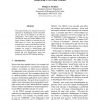15 search results - page 1 / 3 » SenseClusters - Finding Clusters that Represent Word Senses |
EMNLP
2007
13 years 6 months ago
2007
It has been widely observed that different NLP applications require different sense granularities in order to best exploit word sense distinctions, and that for many applications ...
FSKD
2009
Springer
13 years 2 months ago
2009
Springer
Sense Induction is the process of identifying the word sense given its context, often treated as a clustering task. This paper explores the use of spectral cluster method which in...
ACL
2008
13 years 6 months ago
2008
This paper introduces an unsupervised vector approach to disambiguate words in biomedical text that can be applied to all-word disambiguation. We explore using contextual informat...
LREC
2008
13 years 6 months ago
2008
Word Sense Disambiguation (WSD) is an intermediate task that serves as a means to an end defined by the application in which it is to be used. However, different applications have...
IHI
2010
12 years 11 months ago
2010
Unsupervised word sense discrimination relies on the idea that words that occur in similar contexts will have similar meanings. These techniques cluster multiple contexts in which...

